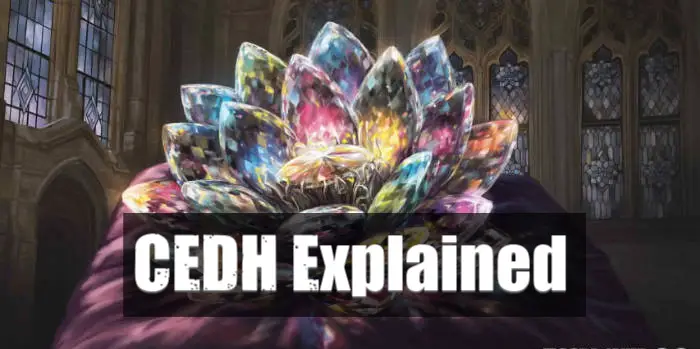Magic: the Gathering has a ton of different terms and abbreviations. It can be a lot to keep up with even for a seasoned player.
You may have seen the term cEDH written, or heard people talking about it at your local game store. What exactly does it mean though? Let’s find out.
cEDH is an abbreviation meaning “Competitive Elder Dragon Highlander”. This is a version of the Commander format where players build their decks to be as powerful and competitive as possible. In contrast to regular Commander, where most play-groups strive for balanced and relaxed gameplay, in cEDH, the name of the game is winning by any means possible.
cEDH is a surprisingly complex subject with lots of debate and varied opinions concerning it. In this article, I’ll break down everything you need to know, plus I’ll go through the most popular cEDH commanders out there today!
What Is cEDH?
cEDH is a variant of the Commander format where players build the most competitive decks possible. The rules are exactly the same as regular Commander. The cards that are legal in the format are also exactly the same. In fact, there really are no official differences between cEDH and regular EDH. And cEDH isn’t recognized by Wizards of the Coast as it’s own format or anything.
Instead, cEDH is basically just Commander players agreeing to go all-out with their deck-building and to be as competitive as possible by any means legal within the official Commander rules.
This agreement amongst players to all play the format with the same intention, however, has almost led to an entirely new format. Nowadays, there’s a whole community devoted to cEDH, and the pseudo-format plays very differently than your average Commander match.
RELATED: Unfinity Lands – Full-Art Basics And Ravnica Shock Lands
What Does cEDH Stand For?
cEDH stands for Competitive Elder Dragon Highlander. For those who might not know, “Elder Dragon Highlander” is another (actually the original) name for the Commander format. And so cEDH simply means “Competitive Commander”.
How Is cEDH Different from Commander?
As I mentioned above, cEDH and regular EDH don’t have any official differences. The rules are all exactly the same. The cards you’re allowed to use are exactly the same. What’s different, however, is the deck-building strategy.
Most Commander play groups lean toward the casual end of the spectrum. This means that, when building decks, players don’t focus too much on getting the highest possible power-level out of their cards. Of course they still want their deck to be good, and they still want to win. They don’t, however, go out of their way to build a deck that can win as quickly and efficiently as possible.
With cEDH, on the other hand, players know that they’ll be facing the very best decks the Commander format has to offer, and they build their decks accordingly. They know they’ll have to win the game fast and/or stop their opponents from executing their own lightning-fast win-conditions.
That brings me to the next main difference between EDH and cEDH: game speed. cEDH is so much faster than regular Commander. It’s common for cEDH games to only last between five to seven turns total. And that’s considering that most most pods are filled with counter spells and other ways to stop players from winning quickly. If left unchecked, a lot of cEDH decks can win on turn three or even earlier.
On the other hand, regular EDH games usually last between 12 and 15 turns.
So how do cEDH decks win so much faster than their more casual counterparts? Well, usually by using fast-mana and tutors to put together game ending combos. I’ll go into greater details about the most common strategies and cards later on in this article.
| cEDH | EDH |
| Prioritizes winning/locking the game down as quickly as possible. | Prioritizes fun/interesting gameplay and deck-building. |
| Uses lots of fast-mana. tutors, free spells and combos to win on the spot. | Uses broader, “fairer” strategies to eliminate opponents over the course of many turns. |
RELATED: The Best Budget Commander Decks
Is cEDH Proxy Friendly?
Yes, cEDH is very proxy friendly!
For those who might not know, a “proxy” is an unofficial card or marker used to represent a real magic card in a deck. Players often use proxies when they don’t have access to, or don’t want to risk damaging, real cards. This is often because cEDH cards are so expensive.
A lot of players simply can’t afford to shell out the money it takes to put together a competitive deck without using proxies. And even players that do own the cards they need often don’t want to risk damaging those cards by playing with them.
Proxies are an important part of cEDH, since, as the name implies, everyone wants the meta to be as competitive as possible. It’s practically impossible for everyone to fully optimize their decks without using proxies.
It is, however, a good idea to check with your playgroup and make sure everyone is on the same page before bringing a deck filled with a ton of proxies. Official events are also another matter entirely, and you should check with the store hosting the event.
With that being said, the community as a whole is very open to proxies, and you should have no problems. Just be sure to have the card info easily readable if you’re planning on using homemade proxies.
What Makes a Deck cEDH?
There is no hard and fast criteria for what makes a deck cEDH. Obviously, it should be competitive, meaning the deck should be able to put up a fight against other top-tier decks. If you show up to a cEDH table with a casually built deck, it’s not going to be fun for you or your opponents.
With that being said, a deck doesn’t have to be perfect to be used for cEDH. There’s nothing wrong with trying a deck out and seeing if it has what it takes to hang. This is how a lot of players get into cEDH and learn the ins and outs of the psuedo-format.
I’ll list a few characteristics of typical cEDH decks to help you get an idea of what makes decks competitive. Almost every cEDH deck has:
- Cheap ways to stop opponents from winning early. This includes cards like Force of Will, Force of Vigor, Counterspell, Noxious Revivaletc.
- Cheap ways to find the cards you need to win the game. These ae cards like Demonic Tutor, Mystical Tutor, Demonic Consultation, Entomb, Gamble etc.
- Cheap ways to get extra mana and allow the deck to pull off its win-con early. These are cards like Dark Ritual, Mana Crypt, Mana Vault, Sol Ring, Culling the Weak, Black Lotus etc.
And then, of course, each deck also needs a way to win the game. This is usually done with some sort of combo. In cEDH, decks usually want to win on the spot, or at least take complete control of the game on the spot.
What Are Some cEDH Staples?
In some ways, cEDH is actually kind of simple. The strategies are streamlined and well-defined, and almost all decks have several cards in common. Here I’ll list the most used cards in the format.
Mana Crypt
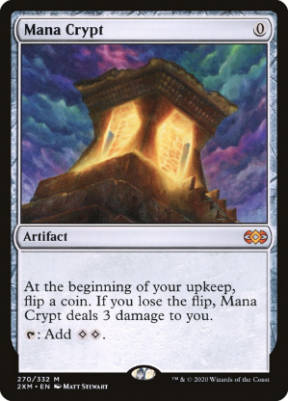
Mana Crypt is perhaps the best mana-rock in the game. It’s completely free to play, and gives you an extra two mana every single turn. Sure, if you lose the coin-toss it deals three damage to you on your upkeep, but the rewards far outweigh the risk. Mana Crypt is so powerful that it’s an easy auto-include in every competitive deck.
Jeweled Lotus
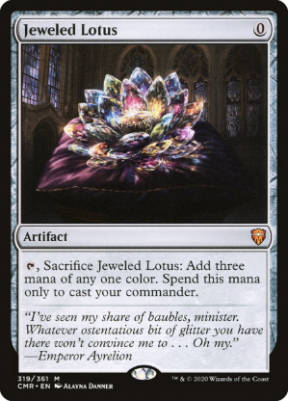
Jeweled Lotus is a Black Lotus that can only be used to cast your commander. It’s completely free to cast and gives you three mana of any one color, allowing many players to play their commanders on turn one.
Force of Will
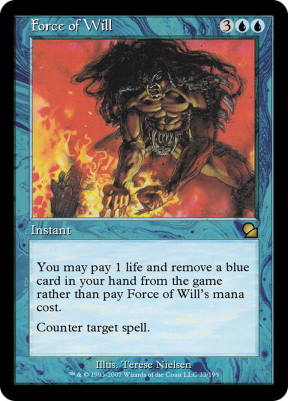
Force of Will is a five-mana counterspell with a powerful twist. Instead of paying the mana-cost, you can exile a blue card from your hand and pay one life. Force of Will is an amazing card for stopping your opponents from winning, as well as protecting your own win-con. As such, FOW is used in pretty much every competitive blue deck that exists.
Fierce Guardianship
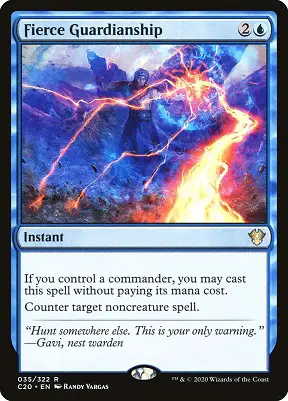
Fierce Guardianship is another potentially free counter spell. As long as your commander is on the battlefield, you can cast Fierce Guardianship without paying its mana-cost.
Survival of the Fittest

Survival of the Fittest is insane. It’s a tutor that stays on the field for you to use multiple times. It also lets you dump a card in the graveyard every time you use it, giving crazy combo potential.
Recent Cards
Ledger Shredder
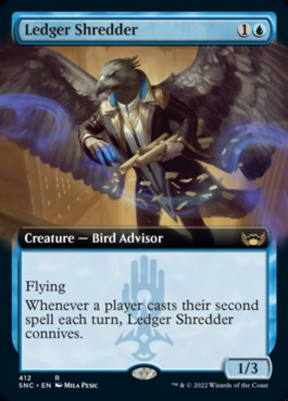
Ledger Shredder is exactly the type of card that competitive decks love. It’s cheap to cast; it gives you a ton of card advantage, it blocks well, and it can quickly become a threat.
Boseiju, who Endures

Boseiju, Who Endures has quickly become a staple in green decks, and it’s no wonder why. There’s very little downside to playing Boseiju, and there’s so much upside. At worst, Boseiju functions like a basic forest, and at best, it’s an extremely cheap and versatile removal spell.
How Do You Get Started in cEDH?
So you’ve decided you’d like to try your hand at cEDH. Where do you start?
Well first you’ll need to build a deck.
cEDH isn’t as hard to get into as many players believe. Sure, most decks are expensive to build in paper. But thankfully, as I mentioned above, proxying is widely accepted. This means that you don’t actually have to own every card you want to use.
It’s also possible to cut your costs significantly by building a mono-colored deck. This removes the need for costly non-basic lands.
Furthermore, when you’re first starting out, you don’t even need to build your deck in paper. I recommend using one of the many websites or applications that allow players to put together a deck list and draw hands from it. This is called “goldfishing” and is an amazing way to start building, or to finetune, a new deck.
Once you have a deck put together, the next step is to find a playgroup. The best way to do this is to go to your local game store and ask around. You can also find online playgroups using applications like “Spelltable” and “Coackatrice”.
And remember, everyone starts somewhere. For the most part, cEDH players, and MTG players in general, are very welcoming and helpful to newer players. So don’t be afraid to get out there and start making playmates!
Popular cEDH Commanders
Zur, the Enchanter
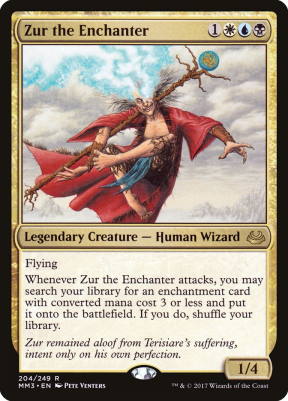
Zur, the Enchanter is a popular cEDH commander that synergizes perfectly with enchantment heavy combos. Every time you attack with Zur, you get to search your deck for any enchantment card with mana-value three or less and attach it to him for free. This tutor effect gives Zur a ton of power, and also gives decks great versatility.
Kenrith, the Returned King

Kenrith, the Returned Kind is an extremely popular cEDH commander. At 5/5 for five mana, his stats might not seem too competitive at first. It’s really his five activated abilities, however, that make him great. Kenrith can draw you cards. He can reanimate creatures. He can give your creatures +1/+1 counters and haste. And he can gain you life. In other words, Kenrith does it all! You just need the mana, which cEDH decks are great at getting.
Kinnan, Bonder-Prodigy
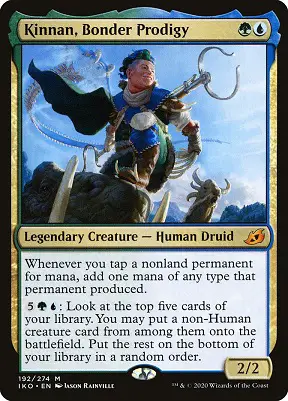
Kinnan, Bonder-Prodigy is a cEDH powerhouse. He costs just two mana to bring out, and then he doubles all of the mana you get from non-land permanents. It’s not difficult to imagine how things can quickly get out of hand with Kinnan on the battlefield.
Najeela, the Blade-Blossom

Najeela, the Blade-Blossom is one of the most powerful commanders in the game. She’s cheap to cast, and it’s so easy to put together a game winning combo with just her and a few other cards.
RELATED: MTG Tournament Play: A Guide to Getting Started
End Step
While not for everybody, cEDH is an amazing way to play Magic. The explosive high risk, high reward gameplay is sure to keep players coming to the table again and again.
I hope this article has answered any and all questions you might have. If not, drop a comment down below and I’ll be happy to answer it.
Now there’s nothing left to do but get out there and try your hand at competitive commander!
